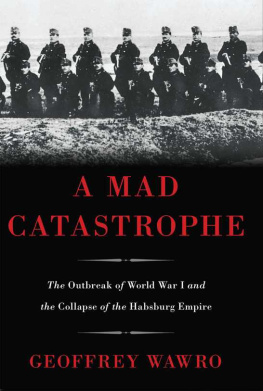THE HABSBURGS

T HE H ABSBURGS
Dynasty, Culture and Politics

PAULA SUTTER FICHTNER
REAKTION BOOKS
Published by Reaktion Books Ltd
33 Great Sutton Street
London EC1V 0DX, UK
www.reaktionbooks.co.uk

First published 2014
Copyright Paula Sutter Fichtner 2014
All rights reserved
No part of this publication may be reproduced, stored in a retrieval system, or transmitted, in any form or by any means, electronic, mechanical, photocopying, recording or otherwise, without the prior permission of the publishers
Page references in the Photo Acknowledgements and
Index match the printed edition of this book.
Printed and bound in Great Britain
by TJ International, Padstow, Cornwall
A catalogue record for this book is available from the British Library
eISBN: 9781780233147
C ONTENTS

Political Chronology

c. 976
German Emperor Otto I makes Leopold I of Babenberg margrave of Eastern March
1156
Privilegium Minus. Margrave Henry II of Babenberg and his Austrian lands raised to ducal status by Emperor Frederick I Barbarossa. Austrian rulers largely freed from imperial feudal obligations in their own holdings. Vienna made government seat
12301246
Frederick II the Quarrelsome, duke of Austria. Further consolidation of Austrian lands, with the exception of Carinthia and the Tyrol. Acquisition of territory along Adriatic coast. Extinction of Babenberg line. Otakar II of Bohemia invades Austria
1251
Austrian estates name Otakar II of Bohemia their duke
1254
Peace of Buda divides Babenberg inheritance between kingdoms of Bohemia and Hungary
12659
Otakar II of Bohemia enfeoffed with Austria, Styria, Carinthia and Carniola by Richard of Cornwall, co-claimant to title of Holy Roman Emperor
1273
Count Rudolph of Habsburg elected German king by imperial estates
12768
Imperial campaign against Otakar II, ending with his death
12823
Rudolph I, as German king, enfeoffs himself with Austrian lands
13589
Privilegium Maius. Habsburgs take title of archduke, a rank confirmed by Emperor Frederick III in 1452
1379
Intra-dynastic division of Habsburg Austrian lands
144093
Archduke Frederick V of Habsburg serves as Holy Roman Emperor Frederick III. With one short interruption, the title remains in the House of Habsburg until dissolution of Holy Roman Empire in 1806
1477
Archduke Maximilian I marries Mary, duchess of Burgundy
14931519
Emperor Maximilian I rules reunited Habsburg holdings
1495
Marriage of Habsburg Archduke Philip of Burgundy and Princess Juana of Spain
1515
Double betrothals of Archduke Ferdinand I with Princess Anna of Hungary and Archduchess Mary with Prince Louis II of Hungary
1517
German Augustinian monk Martin Luther challenges papal authority over western Christendom. Beginning of Protestant Reformation
1526
Crushing Ottoman defeat of Hungarians at Battle of Mohcs. Upon death of Hungarian king Louis II, Ferdinand I of Austria acquires thrones of Hungary and Bohemia
1529
First unsuccessful Ottoman siege of Vienna
1555
Peace of Augsburg accepts coexistence of Catholic and Lutheran territories in Germany
1618
Defenestration of Prague. Bohemian estates choose German Elector Palatine Frederick V as their king rather than Habsburg Emperor Ferdinand II. Beginning of Thirty Years War
1620
Forces of Emperor Ferdinand II defeat army raised by the Bohemian estates at the White Mountain on the outskirts of Prague
1627
Ferdinand IIs Renewed Land Ordinances in Bohemia confirm hereditary Habsburg rule in the kingdom. Estates retain fiscal prerogatives and right to elect monarch should ruling dynasty die out
1635
Emperor Ferdinand II declares primogeniture rule of territorial succession in the House of Habsburg
1648
Treaties of Westphalia. End of Thirty Years War and Habsburg attempt to re-Catholicize Germany
1683
Second Ottoman siege of Vienna fails. Beginning of Habsburg consolidation of Hungarian crown lands and retreat of Ottoman forces to the southeastern Balkans
1699
Peace of Karlovc. Hungary effectively reunited
1700
Death of King Charles II of Spain. Extinction of Habsburg Spanish line
170114
War of the Spanish Succession. Habsburgs give up claims to Spanish throne. Anti-Habsburg Rkczi uprising in Hungary
1713
Pragmatic Sanction asserts the unity of the Habsburg lands should Emperor Charles VI not leave male heirs
1717
Habsburg army under Prince Eugene of Savoy begins temporary occupation of fortifications at Belgrade after dislodging Ottoman defenders
1736
Marriage of Archduchess Maria Theresa to Duke Charles of Lorraine
1740
Maria Theresa succeeds her father Charles VI in Habsburg lands. House of Habsburg now House of Habsburg-Lorraine. War of the Austrian Succession (First and Second Silesian Wars). Frederick II of Prussia invades Silesia, part of the Habsburg kingdom of Bohemia
1748
Treaty of Aix-la-Chapelle. Frederick II of Prussia takes possession of Silesia. Signatories acknowledge Pragmatic Sanction. Beginning of major reform of Habsburg administration
1756
Seven Years War (Third Silesian War). Austria launches unsuccessful effort to retake Silesia
1763
Treaty of Hubertusberg. Prussian takeover of Silesia confirmed in return for Frederick IIs support of Maria Theresas eldest son, Archduke Joseph, as Holy Roman Emperor in 1765
1772
First Partition of Poland. Galicia, area around Krakw, parts of Ukraine, added to Habsburg empire
17789
War of the Bavarian Succession
178090
Reign of Emperor Joseph II. Intense focus on reforming administrative, economic, political and intellectual life of Habsburg lands
1791
Declaration of Pillnitz. Emperor Leopold II and King Frederick William of Prussia raise possibility that they will intervene in revolutionary France where Leopolds sister Marie Antoinette is queen
1792
France declares war on Habsburg monarchy
1795
Third Partition of Poland. Habsburgs receive additional territory around Krakw
17967
Napoleon Bonaparte leads campaign against Habsburg lands in northern Italy
1806
Dissolution of the Holy Roman Empire. Habsburg Holy Roman Emperor Francis II becomes Emperor Francis I of Austria
1809
Bonaparte occupies Vienna
1809
Marriage of Napoleon Bonaparte and Archduchess Marie Louise, eldest daughter of Francis I of Austria
181415
Congress of Vienna. Habsburg monarchs given presidency of new German Confederation
18489
Revolutions take place throughout Habsburg holdings. In December Archduke Franz Joseph becomes emperor of Austria
1849
Suppression of revolution throughout the Habsburg empire. Beginning of Habsburg neo-absolutism
1851
Emperor Franz Joseph declares supremacy of emperor in his New Years Patent. Administration of Habsburg holdings centred on Vienna
1859
Austro-Piedmontese War













